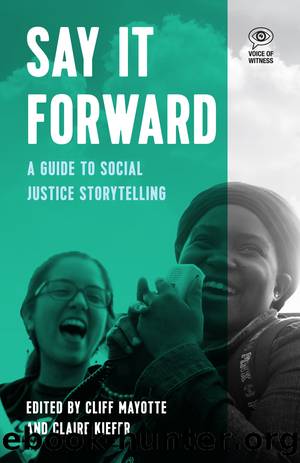Say It Forward: A Guide to Social Justice Storytelling by Cliff Mayotte & Claire Keifer

Author:Cliff Mayotte & Claire Keifer [Mayotte, Cliff & Keifer, Claire]
Language: eng
Format: epub
Tags: Political Science, Human Rights, Social Science, Methodology
ISBN: 9781608469581
Google: xLFmswEACAAJ
Amazon: B07KWGWVQ4
Barnesnoble: B07KWGWVQ4
Goodreads: 43523812
Publisher: Haymarket Books
Published: 2018-01-15T13:39:33+00:00
Find a System That Works for You
From the five interviews I collected, there were about seven and a half hoursâ worth of audio recordings. The transcription process took me a little more than a month to complete.4 While transcribing, I made sure to keep a summary log for each transcript. The summaries included the subjects covered and their corresponding time. This helped immensely once I began writing. I know that some people get others to help them with their transcription. The process can be draining, but I think it is necessary to have an organizational system in place that you created and implemented yourself by the time you start writing. There are books on oral history theory that can provide detailed organizational systems.5 These can often be complicated and at times unhelpful, but if you take a âGoldilocksâ approach, you can find or create a system that works for you. The goal isnât to duplicate someone elseâs process or arbitrarily choose an organizational system just because it works for someone else, but to create a system that will allow you to access your research reliably and efficiently.
By the end of the transcription process, I had picked a few themes to focus on. Rather than include the interviews as a whole, I separated my paper into three chaptersâintegrating the interviews into an overarching narrative. The first chapter outlined the events leading up to and including the storm. The second focused on the narratorsâ transition to Houston. The third looked at the impact of the narratorsâ relocation on their lives in Houston and the impact on the city of New Orleans.
For each of these three chapters I assigned labels and tags like those you would find, for instance, with a YouTube video of a dog playing fetchââdog,â âplaying,â âdog trick,â and so on. I gave tags to my interviews and research that would later become the topics of paragraphs and pages within the chapters. Each tag received its own color. I assigned a tag for the debate on the word refugee, one for the change in New Orleans, and another for Houston traffic. All of these topics appeared in my background research as well as the interviews. And for every time they appeared in the text, they received their corresponding label. When I wanted to find where my sources talked about displacement, for example, I just looked for the yellow tab. This organized my thoughts and helped me start writing.
Once I finished my paper, I presented my project at a symposium with several other students who had also completed their own oral histories. There were about forty-five to fifty people there, most of whom were family and friends of the presenters. I spoke about my project, the work I had done, and what it meant to me as a Houstonian and a resident of the Gulf Coast for these people to trust me to record their stories. After I finished there was a short five-minute question-and-answer session. A woman near the back of the room raised her hand.
Download
This site does not store any files on its server. We only index and link to content provided by other sites. Please contact the content providers to delete copyright contents if any and email us, we'll remove relevant links or contents immediately.
Cecilia; Or, Memoirs of an Heiress — Volume 1 by Fanny Burney(32497)
Cecilia; Or, Memoirs of an Heiress — Volume 2 by Fanny Burney(31910)
Cecilia; Or, Memoirs of an Heiress — Volume 3 by Fanny Burney(31894)
The Great Music City by Andrea Baker(31758)
We're Going to Need More Wine by Gabrielle Union(19003)
All the Missing Girls by Megan Miranda(15779)
Pimp by Iceberg Slim(14435)
Bombshells: Glamour Girls of a Lifetime by Sullivan Steve(14022)
For the Love of Europe by Rick Steves(13598)
Talking to Strangers by Malcolm Gladwell(13292)
Norse Mythology by Gaiman Neil(13280)
Fifty Shades Freed by E L James(13187)
Mindhunter: Inside the FBI's Elite Serial Crime Unit by John E. Douglas & Mark Olshaker(9265)
Crazy Rich Asians by Kevin Kwan(9223)
The Lost Art of Listening by Michael P. Nichols(7454)
Enlightenment Now: The Case for Reason, Science, Humanism, and Progress by Steven Pinker(7274)
The Four Agreements by Don Miguel Ruiz(6702)
Bad Blood by John Carreyrou(6583)
Weapons of Math Destruction by Cathy O'Neil(6219)
